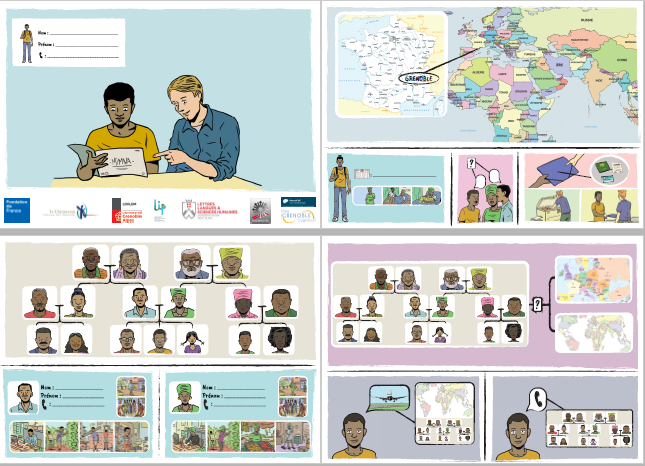- Share
- Share on Facebook
- Share on X
- Share on LinkedIn
In this section
Visual and non-linguistic support to ensure equal access to information for all
AIn order to guarantee access to information for all Unaccompanied and Separated Children (UASC) as soon as they are received, and thereby promote their empowerment [1] regardless of their French skills, their language-culture of origin, the presence or not of an interpreter upon arrival, regardless of their linguistic, academic and cultural profiles, we have adopted a Universal Design approach as defined by the Council of Europe (2009)[2]. This approach aims to integrate, as of the design, all the specific needs to allow the design of accessible, understandable and usable media for all without requiring any particular adaptations[3]. The MIMNA booklet is therefore exclusively visual and non-linguistic[4] to avoid the use of one or more specific languages not mastered by all, and moreover to the written word; this to guarantee equal access to information from everyone to everything.

Autonomization of UASC
Ensuring equal access to information is part of the process of empowering UASC with regard to information, enabling them to build meaningful knowledge to better understand their new socio-cultural environment and to increase their power to act on their environment (empowerment) in the exercise of their fundamental rights[5].
[1] « La notion d’ « empowerment » […] réfère à « la possibilité pour les personnes ou les communautés de mieux contrôler leur vie » (Rappaport, 1987), ou, de façon plus spécifique, à un processus caractérisé par l’exercice d’une plus grande maîtrise sur l’atteinte d’objectifs importants pour une personne, une organisation ou une communauté. (Vallérie & le Bossé, 2006) ["The notion of "empowerment" refers to "the possibility for individuals or communities to better control their lives" (Rappaport, 1987), or, more specifically, to a process characterized by the exercise of greater control over the achievement of important objectives for an individual, an organization or a community. (our translation)]
[2] « Universal Design is a strategy which aims to make the design and composition of different environments, products, communication, information technology and services accessible and understandable to, as well as usable by, everyone, to the greatest extent in the most independent and natural manner possible, preferably without the need for adaptation or specialised solutions.» (Council of Europe, 2009 : 7-8)
[3] In Universal Design, there is also this idea that taking into account specific needs from the design stage will serve other specific or more or less sustainable needs. The access ramp to a building is a fairly telling example of how specific needs (permanent needs of people with reduced mobility) can be taken into account from the design stage, which can also serve the occasional, more or less sustainable accessibility needs of other users: the elderly person on a walker, the person having to move on a crutch, parents with a stroller, the user with a suitcase, etc.... In this case, in the MIMNA booklet, taking into account the needs of low-literacy audiences led us to develop a non-linguistic tool, which, in a similar way to the access ramp, can serve the information needs of all UASC, taking into account the interculturality that marks their reception and support.
[4] With a few rare exceptions, specific words are included in some representations (logo or document title). This will allow some UASC to mobilize not a linguistic skill, but a logographic one (recognition of the word as an image of the written referent) acquired through experience.
[5] This approach is consistent with the inclusive objectives of Universal Design: "promote full participation in community life by ensuring access to and usability of all aspects of society, including the built environment, transport, products and goods, information, public services, education, employment and care ; [...] implement Universal Design as a strategy to ensure equal and democratic rights in society for all individuals, regardless of age, abilities or cultural background, including persons with disabilities." (Council of Europe, 2009 : 7). This approach is also in direct application of the 2002 law on the right of users to be involved in their care, and in particular by strengthening their access to information on their rights in the institutional environment.
- Share
- Share on Facebook
- Share on X
- Share on LinkedIn